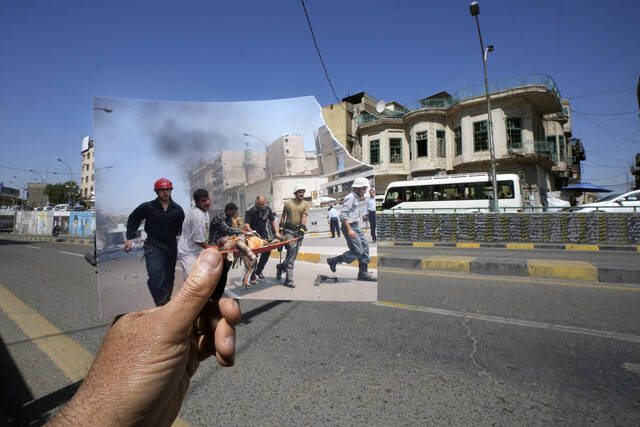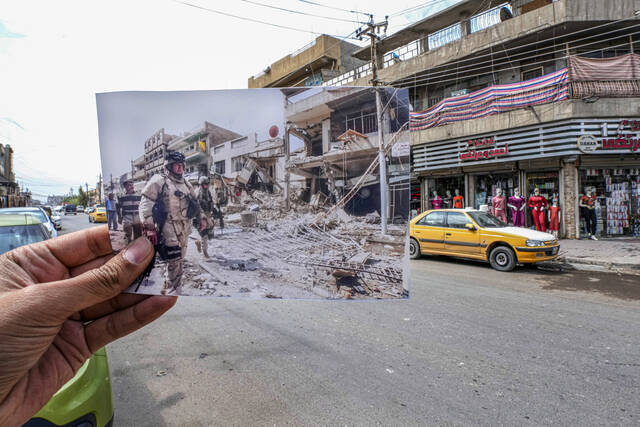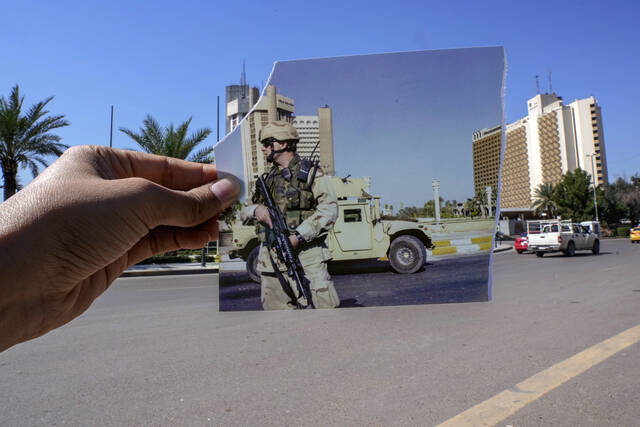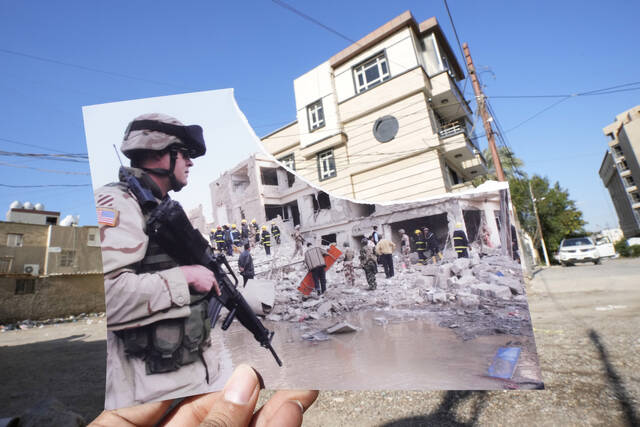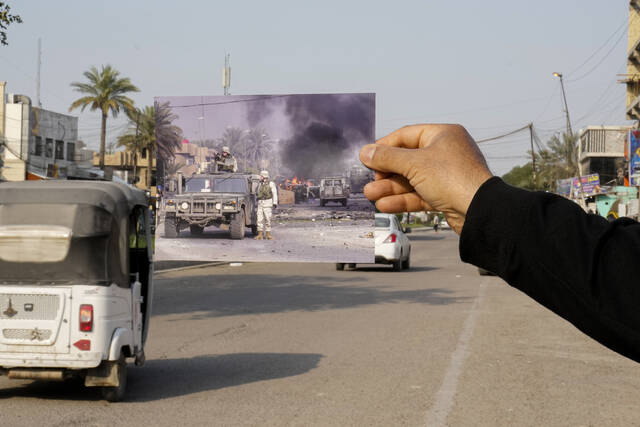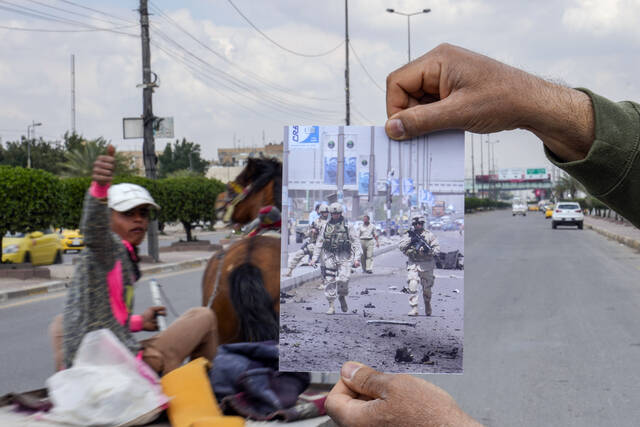Iraq's years of carnage still engrained in Baghdad streets
BAGHDAD — There are places around Baghdad where I’ll sometimes say a silent prayer for the dead when I pass — on certain residential streets, at a particular restaurant, in a square where minibuses gather.
Today, people go about their daily business in these places, perhaps no longer thinking of the horror that took place years ago right where they are walking. For me, each site has become indelibly linked to the carnage I saw and the pain people suffered there.
As an Associated Press photographer, I covered 20 years of turmoil since the U.S.-led invasion of my country. At the height of the sectarian butchery following the invasion, I and other photographers rushed to the scenes of suicide bombings, rocket strikes and shootings around Baghdad nearly every day, sometimes multiple times a day.
Iraqis today remember the pervasive fear of that era, but with so many bombings, the specifics of individual attacks may have faded. This series of composites joins some of my photos from the years of the U.S. occupation and new ones from today, aiming to bring together past and present. Here are the stories behind a few of them.
Sadriyah intersection
In this large intersection jammed with minibuses loading up passengers, a car bomb ripped through the crowds on April 18, 2007, killing at least 140 in what was then one of the deadliest single bombings since the U.S. invasion.
When it went off, I was at the site of that morning’s first bombing, which had killed dozens, and as the firefighters rushed to the second blast, I hitched a ride with them. We were among the first on the scene at Sadriyah. The stench of burned flesh filled my nostrils. Blackened bodies were strewn among twisted, smoldering minibuses. Survivors loaded pieces of human beings onto wooden vegetable pushcarts to take away.
The next day when I went back, I saw the girl. She was with her mother, searching among the remaining debris and body parts. The mother’s feet were bare, covered in ash. She smeared ashes on her face as she screamed for her missing husband: “Ahmed, where did you go? I can’t do it without you. Your daughters need you.”
I saw the look of silent terror in the eyes of the girl as she trailed her mother, holding her little sister and absorbing the scene. I took her picture.
I went back to Sadriyah several weeks ago. The minibuses blared their horns, and people thronged a nearby street market. I relived that day 16 years ago like I was watching it in a cinema. Those closest to a bomb seem to evaporate without a trace, I thought. This intersection was their last resting place.
Camp Sara
This Baghdad district got its name from a wealthy Armenian Christian woman who once owned the area when it was farmland. As Armenians fled oppression in Turkey and elsewhere in the early 20th century, she let refugees settle on her land, and by the 1950s, it was built up as an almost entirely Christian neighborhood.
On Oct. 4, 2006, two car bombs went off within minutes of each a few dozen meters apart on a main commercial street of the district. All along a block of the avenue, buildings were shattered, blackened, a few collapsed almost completely. At least 16 people were killed and dozens wounded. Some young men carried a frail elderly woman on a chair to safety. Others used tarps to carry pieces of bodies. Everyone was running —either away from danger or toward loved ones to see if they were alive.
“You have no God,” a resident named Dureid shouted in his shock as if the militants behind the blast were there to listen. “You are not Muslims. Aren’t these Iraqis? What is their crime?”
The explosion was only one of many by Sunni Muslim extremists that hit Christian areas over the years. Camp Sara was once one of the nicest parts of Baghdad, with good restaurants and a different vibe from the rest of the city. Today, the buildings are cleaned up, but the street looks the same, down to the electricity poles that haven’t moved.
Still, everything has changed. Most of Camp Sara’s Christians have been driven away by violence. Dureid has moved to another part of Baghdad; a man in a striped shirt who stood next to him in my photo is in the United States. Camp Sara has become like any other part of Baghdad, its distinctiveness another victim of that bloody time.
Karradah
It was Army Day, Jan 6, 2008, marking the founding of the Iraqi army, and a little celebration was being held on a street in Karradah, a middle-class area of Baghdad. I was one of several media cameramen there as residents came out to cheer for soldiers. The doorman from one of the houses, Abu Adel, put a flower into the barrel of one soldier’s rifle and kissed him on the cheeks. The next instant, a suicide bomber unleashed his blast.
Only a few yards away, I was thrown to the ground, wrenching my back, but kept taking pictures. The celebration had been transformed into mayhem, with scorched cars and buildings and the torn bodies of 11 dead. Among the dead was Abu Adel.
I went back to the site a few weeks ago. It’s once again a quiet street with its villas and houses. As I took pictures, a doorman from one of the houses approached me. His name was Ali Ahmed. I asked him if he had been here that day and showed him my old photos of the explosion.
Ahmed started to weep. “I should have died that day,” he said. He had been about to go with Abu Adel to put a flower in the soldier’s rifle, but first had to deal with a broken generator. “There were only seconds between me and death,” he said. We found him in the background of one of my photos, behind some bloodied soldiers. I took a new picture of him in the same spot: his older self stepping back into his younger self.
I too nearly died that day. At other times, I felt I was only inches from death, seeing those who by chance were on the wrong side of that thin line. I tell myself God kept me here for my children and my wife. Every day I have with them is a gift.
A place can be bonded to an emotion, like when a couple revisits all the sites where they first fell in love.
Sometimes, that emotion is horror.
Remove the ads from your TribLIVE reading experience but still support the journalists who create the content with TribLIVE Ad-Free.


